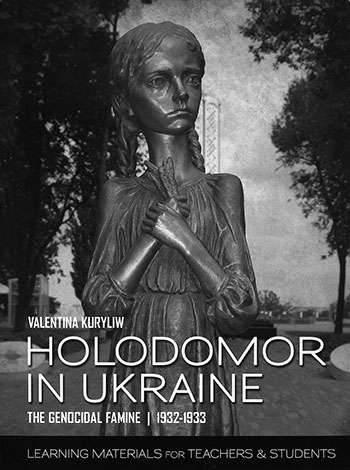BOOK REVIEW: Resource for teachers and students about the Holodomor
 Eighty-five years after it was perpetuated by the Stalin regime, how many non-Ukrainians are aware of the Holodomor Famine Genocide of 1932-1933? Why are the horrors of the Nazis taught extensively in our school systems, yet the genocidal policies of Communist regimes are virtually ignored? Why does the hammer and sickle not elicit the same response as the swastika?
Eighty-five years after it was perpetuated by the Stalin regime, how many non-Ukrainians are aware of the Holodomor Famine Genocide of 1932-1933? Why are the horrors of the Nazis taught extensively in our school systems, yet the genocidal policies of Communist regimes are virtually ignored? Why does the hammer and sickle not elicit the same response as the swastika?
“Holodomor” comes from two Ukrainian words: “holod” meaning starvation and “moryty” to cause death. This Famine came about as a direct result of policies created and imposed on Ukraine by the Soviet regime which covered it up and denied it, ensuring that it would not be known and taught for decades.
It is time to insist that studies about the Holodomor be included in high school curricula and at genocide and Holocaust centers found at many universities. We can all do our part – parents, students and teachers alike. Each of us can make a difference. All it takes is one individual’s insistence.
The Canadian Institute of Ukrainian Studies Press recently published an excellent and much-anticipated resource titled “Holodomor in Ukraine – the Genocidal Famine 1932-1933: Learning Materials for Teachers and Students,” authored by Valentina Kuryliw, director of education of the Holodomor Resource Education Consortium (HREC), and the chair of the National Holodomor Education Committee of the Ukrainian Canadian Congress.
Ms. Kuryliw is a history specialist, a renowned educator in both Canada and Ukraine, and the daughter of two Holodomor survivors. The book is dedicated to her parents; James Mace, who pioneered the study of the Holodomor in Ukraine; and to the millions of innocent victims who were starved to death.
The full-color, illustrated, spiral-bound book includes photographs, maps and charts, lessons and more, providing a wealth of learning materials for teachers and students. The material is organized into four well-thought-out sections.
Part 1 contains the rationale for teaching and studying the Holodomor.
Part 2 consists of learning materials about the historical background of events leading to the Holodomor, including a well-designed timeline of events, basic statistics on lives lost, the responses from governments, journalists and intellectuals to the Holodomor, including its cover-up and denial. It also contains excerpts from Raphael Lemkin’s “Soviet Genocide in the Ukraine.” This comprehensive yet succinct section concludes with the findings of the U.S. Commission on the Ukraine Famine, newspaper articles, primary documents, survivors’ accounts, official government recognitions of the Holodomor as genocide, and a very convenient glossary of terms and of notable people, plus photos and a discussion of the aftermath of the Holodomor.
Part 3 contains age-appropriate learning activities, lesson plans, class projects and assignments for students. It is chock-full of student worksheets and assessment rubrics, all of which can be easily photocopied, thanks to the spiral binding and readily applicable for a variety of courses for grades 5 through high school.
Part 4 is the Appendix, which includes an extensive bibliography with print, online and multi-media resources lists. Of significance here are the author’s favorite “Top Picks” of resources to use and supplemental materials for enthusiastic educators.
This user-friendly book is filled with a plethora of interesting and varied ideas and resources that make use of the latest research on the Holodomor. The lessons provide a contemporary multidisciplinary approach to teaching the Holodomor and can be utilized in teaching social studies, media, religious studies, social justice, literary and visual arts, history and genocide. It is a powerful resource that helps both adults and students connect with this genocide on a personal level, using many critical thinking activities.
The author, Ms. Kuryliw, has made an invaluable contribution to the teaching and engaged learning of the Holodomor with this book, which will undoubtedly ensure that a more thorough understanding of the event and its legacy are spread to wider audiences. It remains only for educators to use it to teach and to further insist on its inclusion in all levels of curricula in their educational institutions.
Since the late 1980s, a small handful of valuable curriculum resources and workbooks related to the Holodomor have been published, but none have approached the scope of this workbook. At just over 300 pages, this book incorporates up-to-date instructional strategies and methodologies that meet contemporary guidelines and engaged critical-thinking practices. Although the orientation is toward Canadian standards, the materials are largely applicable in any English-language instructional setting.
Any concerned individual interested in raising awareness about the genocidal Holodomor would benefit from this resource, particularly schools and universities, libraries and genocide organizations.
This book is a project of the Holodomor Research and Education Consortium, which itself is a project of the University of Alberta.
Orders may be placed online through a secure Internet connection at CIUS Press, ww.ciuspress.com; by e-mail, cius@ualberta.ca; telephone, 780-492-2973; fax, 780-492-4967; or by mail: CIUS Press, 430 Athabasca Hall, University of Alberta, Edmonton, AB, T6G 2H8, Canada.
Oksana Kiciuk-Kulynych is an educator and a member of the U.S. Committee for Ukrainian Holodomor Genocide Awareness.
Soruce: The Ukrainian Weekly